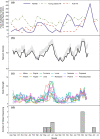Temporal patterns in the social network of core units in Rwenzori Angolan colobus monkeys: Effects of food availability and interunit dispersal
- PMID: 33841781
- PMCID: PMC8019045
- DOI: 10.1002/ece3.7274
Temporal patterns in the social network of core units in Rwenzori Angolan colobus monkeys: Effects of food availability and interunit dispersal
Abstract
Multi-level societies are complex, nested social systems where basic social groups (i.e., core units) associate in a hierarchical manner, allowing animals to adjust their group sizes in response to variables such as food availability, predation, or conspecific threat. These pressures fluctuate over time and examining the extent to which this variation affects the clustering of core units into different tiers may be instrumental in understanding the evolution of multi-level societies.The goal of our study was to determine the degree of temporal variability in interunit associations in a multi-level society of Rwenzori Angolan colobus monkey (Colobus angolensis ruwenzorii), and to determine the social and ecological factors that underlie association patterns. The C. a. ruwenzorii multi-level society consists of at least three tiers, with core units clustering into clans that share a home range in a band tier.We performed social network analyses on 21 months of association data from 13 core units (totaling 139 identifiable individuals) at Lake Nabugabo, Uganda. We described the patterns of variation in core-unit associations over time and investigated how changes in rainfall, food availability, and interunit dispersals were correlated with these associations over the short-term (month to month) and long-term (year to year).Although clans were relatively stable, larger-scale changes in association patterns included the formation of an all-male unit and the transfer of one core unit between clans (within the band tier). Seasonally, core units associated significantly more when fruit, their preferred food source, was abundant (i.e., social networks were denser and more clustered) and there was no direct effect of rainfall seasonality or young leaf availability. Male dispersals also occurred more during periods of high fruit availability, suggesting that greater band cohesion allowed males to prospect and transfer between core units. Once males transferred, their previous and new units associated significantly more with one another than with other core units for 1-2 months postdispersal. The dispersal of five males from one core unit to another in a different clan co-occurred with this core unit switching its clan affiliation.By examining temporal shifts in social network structure among core units, this study shows the interconnected roles that food availability and dispersal have in shaping the C. a. ruwenzorii multi-level social system. Our findings highlight how ecological conditions can drive association patterns, impact interunit relationships, and influence social organization.
Keywords: colobines; core unit associations; food availability; food competition; male dispersal; social network analysis.
© 2021 The Authors. Ecology and Evolution published by John Wiley & Sons Ltd.
Conflict of interest statement
There are no conflicts of interest to declare.
Figures





References
-
- Adams, F. V. , & Teichroeb, J. A. (2020). Microhabitat use in Angolan colobus monkeys (Colobus angolensis ruwenzorii) at Nabugabo, Uganda demonstrates intraspecific variability. International Journal of Primatology, 41, 24–44. 10.1007/s10764-020-00132-z - DOI
-
- Altmann, J. , Alberts, S. C. , Haines, S. A. , Dubach, J. , Muruthi, P. , Coote, T. , Geffen, E. , Cheesman, D. J. , Mututua, R. S. , Saiyalel, S. N. , Wayne, R. K. , Lacy, R. C. , & Bruford, M. W. (1996). Behavior predicts genes structure in a wild primate group. Proceedings of the National Academy of Sciences of the United States of America, 93(12), 5797–5801. 10.1073/pnas.93.12.5797 - DOI - PMC - PubMed
-
- Altmann, S. A. (1998). Foraging for survival: Yearling baboons in Africa. University of Chicago Press.
-
- Aureli, F. , Schaffner, C. M. , Boesch, C. , Bearder, S. K. , Call, J. , Chapman, C. A. , Connor, R. , Fiore, A. D. , Dunbar, R. I. M. , Henzi, S. P. , Holekamp, K. , Korstjens, A. H. , Layton, R. , Lee, P. , Lehmann, J. , Manson, J. H. , Ramos‐Fernandez, G. , Strier, K. B. , & Schaik, C. P. (2008). Fission‐fusion dynamics: New research frameworks. Current Anthropology, 49, 627–654. 10.1086/586708 - DOI
Associated data
LinkOut - more resources
Full Text Sources
Other Literature Sources

